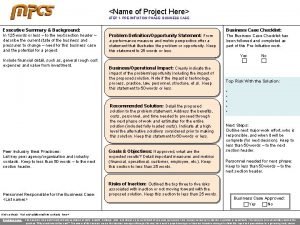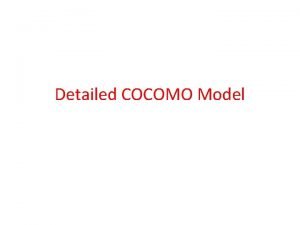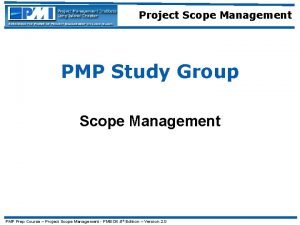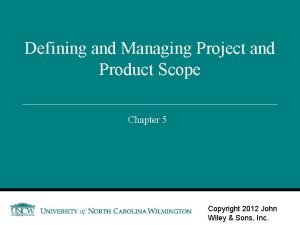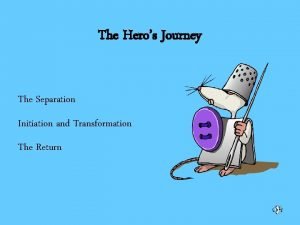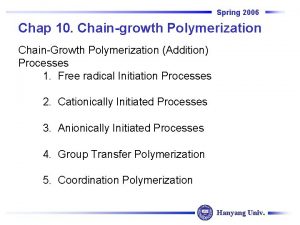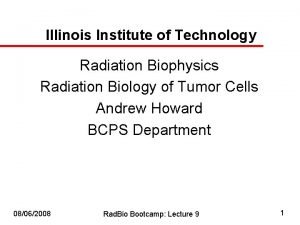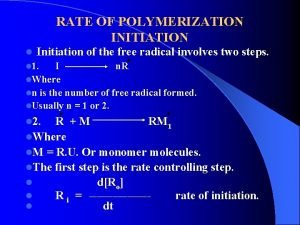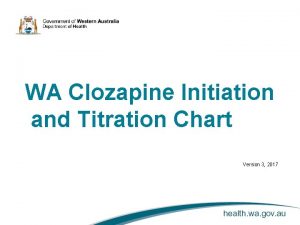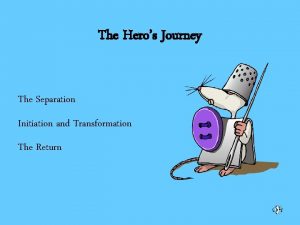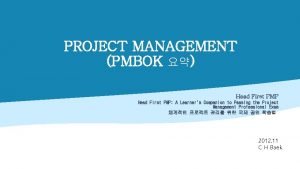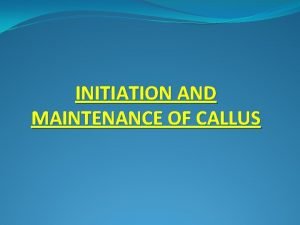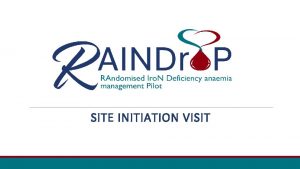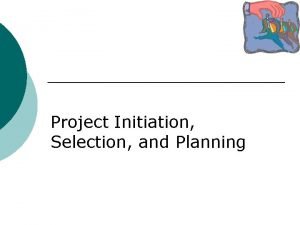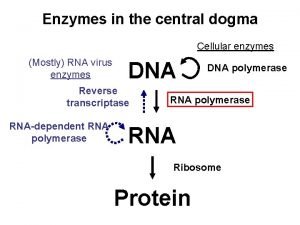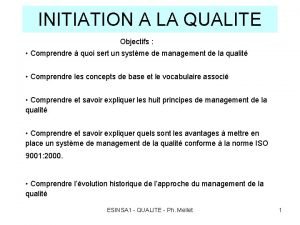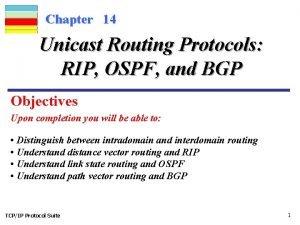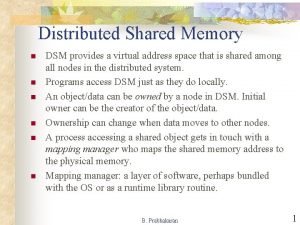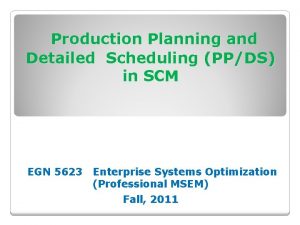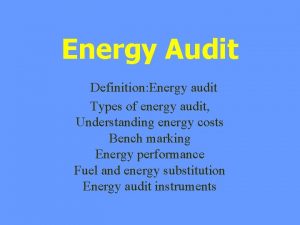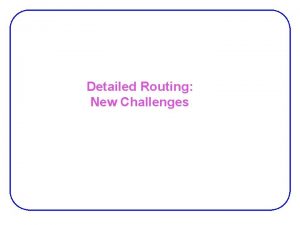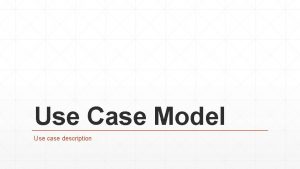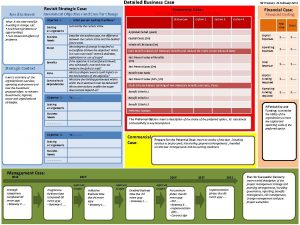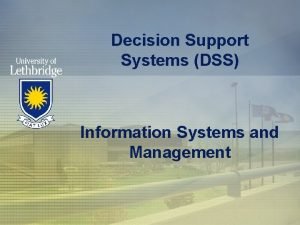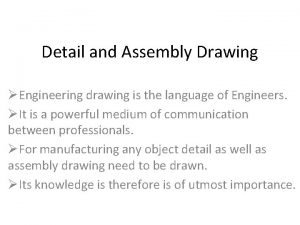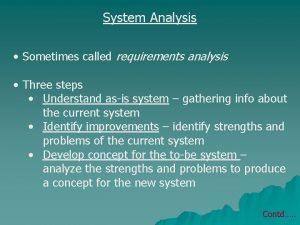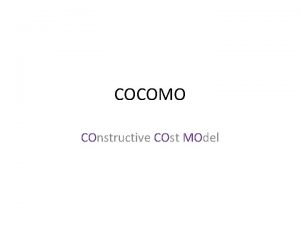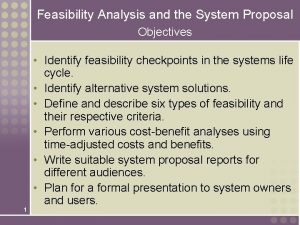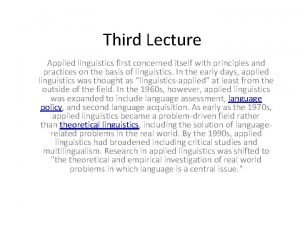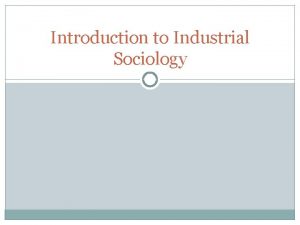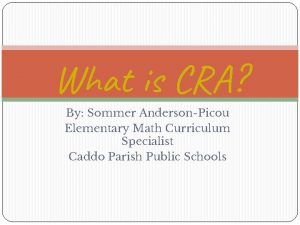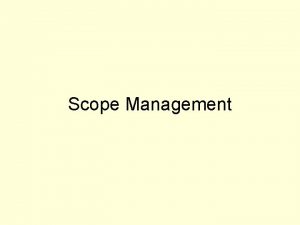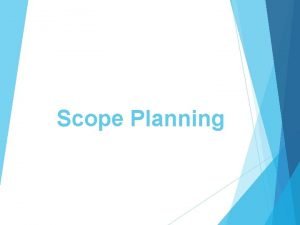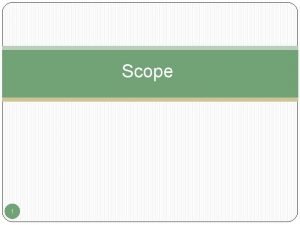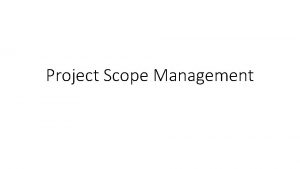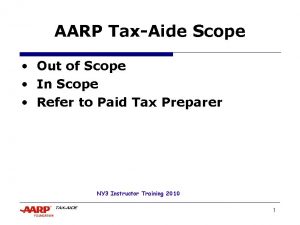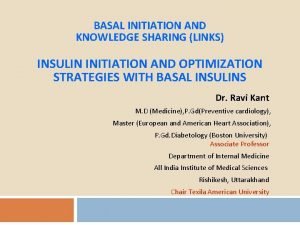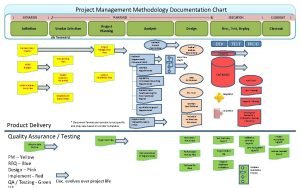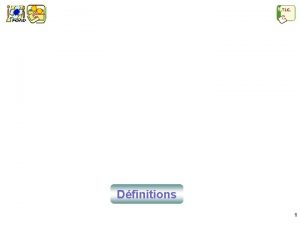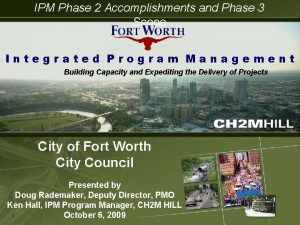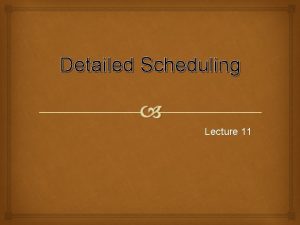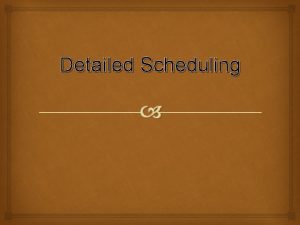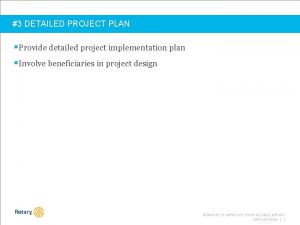A Detailed Look to Initiation Phase of Scope

























































































- Slides: 89

A Detailed Look to Initiation Phase of Scope Management (Part 8) Dr. Çağatay ÜNDEĞER Instructor Bilkent University, Computer Engineering Middle East Technical University, Game Technologies & General Manager Sim. BT Inc. e-mail : undeger@simbt. com. tr CS-413 Bilgisayar Mühendisliği Bölümü – Bilkent Üniversitesi – Fall 2009 1

Scope Management • Project Management Components (knowledge areas) – Project Integration Management – Project Scope Management – Project Time Management – Project Cost Management – Project Human Resource Management – Project Communication Management – Project Quality Management – Project Risk Management – Project Procurement Management CS-413 2

Scope Management Phases • • • CS-413 Initiation Scope Planning Scope Definition Scope Verification Scope Change Control 3

A Detailed Look to: Initiation • The process of identifying and authorizing; – A new project, or – Continuation of an existing project. CS-413 4

A Detailed Look to: Initiation • Requires the following activities: – Identifying projects – Classifying and ranking projects – Selecting projects – Establishing project charter CS-413 5

Identifying projects • • No single method to use Some organizations use; – Very careful planning process; • Some use; – More ad hoc methods. CS-413 6

Identifying projects • CS-413 Who is responsible? – A key member of top management (e. g. a CEO, a senior executive) – A steering commitee composed of managers – User departments; • Head of a requesting unit • A commitee of requesting unit – A senior IS manager 7

Identifying projects • Although carefully identifying new projects has advantages, – Many organizations do not use a systematic planning process. • Projects are resulted from attempts to solve isolated organizational problems. • Procedures are likely to change, – In time, It will be necessary to modify existing systems. CS-413 8

Identifying projects • • CS-413 Use planning based-approachs. Planning based-approachs ask the following question to identify new potential projects: – What information requirements will satisfy; • Decision making needs or • Business process of enterprice today and well in the future? 9

Identifying projects • Advantage of planning-based approach is that; – An organization’s informational needs are less likely to change than its bussiness process. • To understand planning-based approach, need to understand; – Corporate Strategic Planning, and – Information Systems Planning. CS-413 10

Identifying projects (Corporate Strategic Planning) • To make effective decisions, you need to gain a clear idea of; – Where an organization is, – Where it wants to be in the future (vision of organization), and – How to make transitions to that desired future state. • Planners develop a strategic plan to guide the transition. CS-413 11

Identifying projects (Sample Vision Statement) • CS-413 Vision statement of Sim. BT Inc: – To provide national and international science and technology based original solutions in the area of modeling, simulation and simulators. – To realize company revolution on the concept of • “Behaving flexible and simple as a small company, • But meanwhile having the power of a big scale organization". 12

Identifying projects (Corporate Strategic Planning) • • CS-413 All successful organizations hava a mission. Mission statement of a company states what business the company is in. 13

Identifying projects (Sample Mission Statement) • Mission statement of Microsoft: – To enable people and businesses throughout the world to realize their full potential. • Mission statement of Sim. BT Inc: – To develop the best M&S prototypes and turnkey products for Turkish and abroad customers. CS-413 14

Identifying projects (Corporate Strategic Planning) • CS-413 Closely linked to their mission, – Organizations also define several objective statements that refer to broad and timeless goals for the organization • In order to reach a desired future state. 15

Identifying projects (Sample Objective Statement) • CS-413 Objective statements of Microsoft: – Broad customer connection: Connecting with customers, understanding their needs and how they use technology, and providing value through information and support to help them realize their potential. – A global, inclusive approach: Thinking and acting globally, enabling a diverse workforce that. . . –. . . 16

Identifying projects (Sample Objective Statement) • CS-413 Objective statements of Sim. BT Inc: – To bridge the gap among: • “Science, technology, turn-key systems“, • “University, research centers” and • “Industry, acquisition agencies" in the area of modelling, simulation and simulators. – To put ourselves in the position of our customers in order to understand their requirements. – To make our customers realize their requirements and utilize the state-of-the-art technology. 17

Identifying projects (Corporate Strategic Planning) • CS-413 A competitive strategy: – The method by which an organization attempts, to achieve its mission and objective. – An organization’s game plan for playing in the competitive business world. 18

Identifying projects (Corporate Strategic Planning) • CS-413 A competitive strategy: – Generic strategies: • Low-cost producer • Product differentiation • Product Focus 19

Identifying projects (Corporate Strategic Planning) • CS-413 Low-cost producer: – Competing in an industry on the basis of product or service cost to the customer (e. g. very cheap products). 20

Identifying projects (Corporate Strategic Planning) • CS-413 Product differentiation: – Capitalizing on a key criterion requested by the market (e. g. high quality, high performance, original style). 21

Identifying projects (Corporate Strategic Planning) • CS-413 Product Focus: – Similar to both low-cost and differentiation strategies. – But employs a much narrow market focus (focus on some specific products). 22

Identifying projects • CS-413 Planning-based approaches: – Corporate strategic planning, and – Information Systems planning. 23

Identifying projects (Information Systems Planning) • A second planning approach that can help identifying projects is information systems planning (ISP). • An orderly means of; – Assessing information needs of an organization, and – Defining systems, databases, and technologies that will best satisfy those needs. CS-413 24

Identifying projects (Information Systems Planning) • Model current and future organizational information needs. • Develop strategies and project plans – To migrate current information systems and technologies to their desired future state. CS-413 25

Identifying projects (Information Systems Planning) • A top-down process that takes into account; – Outside forces (industry), – Economy, – Relative size, – Geographic region, etc. • Key activities are: – Describing current situation – Describing target situation, trends, and constraints – Developing a transition strategy and plan CS-413 26

Identifying projects (Information Systems Planning) • CS-413 Describing current situation: – Define the current organizational situation using top-down planning. – Top-down planning attempts; • To gain a broad understanding of informational needs of entire organization. 27

Identifying projects (Information Systems Planning) • CS-413 Describing current situation: – Top-down planning; • Begins with analysis of organization’s mission, objectives, and strategy; • Continues with determination of information requirements needed to meet each objective. • Requires involvement of top-level management. 28

Identifying projects (Information Systems Planning) • CS-413 Describing target situation, trends, and constraints: – Define target situation that reflects desired future state of organization. – Vision consists of desired state of; • Locations, • Units, • Functions, • Processes, • Data, • Information systems. 29

Identifying projects (Information Systems Planning) • CS-413 Developing a transition strategy and plan: – When creation of current and target situation is completed, • A detailed transition strategy and plan are developed. 30

Identifying projects (Information Systems Planning) • CS-413 Developing a transition strategy and plan: – Plan should be: • Very comprehensive, • Reflecting broad and long-range issues, and • Providing sufficient detail to guide all levels of management concerning; – What needs to be done, – How and when it needs to be done, – Who in organization will be doing. 31

Identifying projects (Information Systems Planning) • Developing a transition strategy and plan: – Outline of an information systems plan: • Organizational mission, objectives & strategy • Information inventory • Mission and objectives of IS • Constraints on IS development • Overall systems needs and long-range IS strategies • The short-term plan • Conclusions CS-413 32

Identifying projects (Information Systems Planning) • CS-413 Developing a transition strategy and plan: – Organizational mission, objectives & strategy: • Briefly describes mission, objectives and strategy of the organization. • Presents current and future views of the organization briefly. 33

Identifying projects (Information Systems Planning) • CS-413 Developing a transition strategy and plan: – Information inventory: • Provides a summary of various bussiness process, functions, data entities, and information needs of enterprise. • Will contain both current and future views. 34

Identifying projects (Information Systems Planning) • CS-413 Developing a transition strategy and plan: – Mission and objectives of IS: • Describes primary role of IS in transformation from current to future state. • For example, role may be; – A necessary cost, – an investment, or – a strategic advantage. 35

Identifying projects (Information Systems Planning) • CS-413 Developing a transition strategy and plan: – Constraints on IS development: • Briefly describes limitations imposed by; – State of the art technology, – Current level of resources within the organization (financial, technological, personnel). 36

Identifying projects (Information Systems Planning) • CS-413 Developing a transition strategy and plan: – Overall systems needs and long-range IS strategies: • Presents a summary of; – Overall systems needs within the organization, – A set of long-range (2 -5 years) strategies chosen by IS department to meet the needs. 37

Identifying projects (Information Systems Planning) • CS-413 Developing a transition strategy and plan: – The short-term plan: • Shows; – A detailed inventory of present projects and systems, – A detailed plan of projects to be developed or advanced during current year. 38

Identifying projects (Information Systems Planning) • CS-413 Developing a transition strategy and plan: – Conclusions: • Contains; – Likely, but not certain events that may effect the plan, – An inventory of business change elements as presently known, – A description of their estimated impact on plan. 39

A Detailed Look to: Initiation • Requires the following activities: – Identifying projects – Classifying and ranking projects – Selecting projects – Establishing project charter CS-413 40

Classifying and Ranking Projects • Focuses on assessing relative merit of potential projects. • All projects are feasible given unlimited resources and time, – But most projects must be developed within tight budgendary and time constraints. – Therefore, assessing feasibility and value of projects is essential. CS-413 41

Classifying and Ranking Projects • CS-413 Factors: – Economical – Technical – Operational – Schedule – Legal and contractual – Political 42

Classifying and Ranking Projects • CS-413 Economical Feasibility: – A comparison of financial benefits and costs associated with a development project. – Often reffered as Cost-Benefit Analysis. – Impossible to preciesly define costs and benefits, – But an estimation is required in order to compare rival projects. 43

Classifying and Ranking Projects • CS-413 Economical Feasibility: – Determine project benefits: • Tangible benefits • Intangible benefits – Determine project costs: • Tangible costs • Intangible costs 44

Classifying and Ranking Projects • CS-413 Economical Feasibility: – Tangible benefits; • Can be measured in money and with certainty. 45

Classifying and Ranking Projects • CS-413 Economical Feasibility: – Categories of tangible benefits: • Cost reduction and avoidance, • Error reduction, • Increased flexibility, • Increased speed of activity, • Improvement of management, planning and control, • Opening new markets and increasing sales opportunities, • Others. 46

Classifying and Ranking Projects • CS-413 Economical Feasibility: – Intangible benefits; • Cannot be easily measured in money. – Some tangible benefits may be intangible in early stages of a project. 47

Classifying and Ranking Projects • CS-413 Economical Feasibility: – Categories of intangible benefits: • Increased competiveness with other companies, • Increased organizational flexibility, • Increased employee morale, • Increased organizational learning and understanding, • More timely information collection, • Others. 48

Classifying and Ranking Projects • CS-413 Economical Feasibility: – Tangible costs; • Can be measured in money and with certainty. 49

Classifying and Ranking Projects • CS-413 Economical Feasibility: – Categories of tangible costs: • Hardware costs, • Software costs, • Labor costs, • Operational costs (employee training, building renovations, etc. ) • Others 50

Classifying and Ranking Projects • CS-413 Economical Feasibility: – Intangible costs; • Cannot be easily measured in money. 51

Classifying and Ranking Projects • CS-413 Economical Feasibility: – One-time cost: • A cost associated with; – Project start-up and development or – System start-up. – Recurring costs: • A cost resulting from ongoing evolution and use of a system. 52

Classifying and Ranking Projects • CS-413 Economical Feasibility: – Cost-benefit analysis: • The use of a variety of analysis techniques for determining financial feasibility of a project. 53

Classifying and Ranking Projects • CS-413 Economical Feasibility: – Cost-benefit analysis: • Commonly used analysis techniques: – Net present value (NPV) – Return on Investment (ROI) – Break-even analysis (BEA) 54

Classifying and Ranking Projects • CS-413 Economical Feasibility: – Cost-benefit analysis: • Development and useful life of a system may span several years. • Therefore, costs and benefits must be normalized into present day in order to compare. • Time value of money (TVM) is used, – In order to compare present cash outlays to future expected returns. 55

Classifying and Ranking Projects • CS-413 Economical Feasibility: – Cost-benefit analysis: • The rate at which money can be borrowed or invested is called; – The cost of capital, or – Discount rate. 56

Classifying and Ranking Projects • Economical Feasibility: – Cost-benefit analysis: • Formula to compute present value of a money that will be available in the future: Amount of money that will be available n years from now Present value PVn = Y x 1 (1+i)n Discount rate in a year CS-413 Number of years required for money become available 57

Classifying and Ranking Projects • CS-413 Economical Feasibility: – Cost-benefit analysis (Example): • A seller sells a car for 4500 TL; – By 3 instalments. » 1500 TL in cash, » 1500 TL after 1 year, » 1500 TL after 2 years. • If seller were able to put money in a bank, – Would receive 10 percent return in a year for his/her investment. 58

Classifying and Ranking Projects • Economical Feasibility: – Cost-benefit analysis (Example): • 1500 TL in cash: – • 1 PV 2 = 1500 x (1+0. 10)1 = 1363 TL 1500 TL after 2 years. – CS-413 = 1500 TL after 1 year, – • PV 1 1 PV 3 = 1500 x (1+0. 10)2 = 1239 TL 59

Classifying and Ranking Projects • CS-413 Economical Feasibility: – Cost-benefit analysis (Example): • Seller will actually benefit; » 4102 TL (Net PV = 1500+1363+1239) – From 4500 TL sale. 60

Classifying and Ranking Projects • CS-413 Economical Feasibility: – Cost-benefit analysis (Example): • Seller will actually benefit; » 4102 TL (Net PV = 1500+1363+1239) – From 4500 TL sale. • Therefore, if buyyer gives equal to or more than 4102 TL in cash, – Seller will accept (if he/she knows enough matematics ). 61

Classifying and Ranking Projects • CS-413 Economical Feasibility: – Cost-benefit analysis: • To perform analysis, – Useful life of project and – Cost of capital must be determined. 62

Classifying and Ranking Projects • Economical Feasibility: – Cost-benefit analysis: • Overall return on investment (ROI): – A useful value for trade-off analysis among projects. ROI = 35. 003 = 0. 24 145. 236 CS-413 63

Classifying and Ranking Projects • Economical Feasibility: – Cost-benefit analysis: • Break-Even Analysis: – Used to discover at what point benefits will equal to costs. Break-even occurs between year 2 and 3 CS-413 64

Classifying and Ranking Projects • Economical Feasibility: – Cost-benefit analysis: Break-Even ratio = Yearly NPV Cash Flow – Overall NPV Cash Flow Yearly NPV Cash Flow 15. 303 – 9. 139 = 0. 403 15. 303 Project break-even occurs at 2. 403 years. CS-413 9. 139 – (-6. 164) 65

Classifying and Ranking Projects • CS-413 Factors: – Economical – Technical – Operational – Schedule – Legal and contractual – Political 66

Classifying and Ranking Projects • CS-413 Technical Feasibility: – An assesment of the developer organization’s ability to construct a proposed system. – Should include understanding of; • Target hardwares, • Target softwares, • Target operating systems, • Size and complexity of project, • Experience of groups involved. 67

Classifying and Ranking Projects • CS-413 Technical Feasibility: – All projects have risks. – Risk is not necessarily something to avoid. – Organizations typically expect a greater return on their investments for riskier projects. – Important thing is; • To understand risks and • To manage them in order to minimize. 68

Classifying and Ranking Projects • CS-413 Technical Feasibility: – Primary factors for risk: • Project size, • Project structure, • Developer group’s experience with application and technology area, • User group’s experience with systems development projects and application areas. 69

Classifying and Ranking Projects • CS-413 Technical Feasibility: – Project size: • Larger projects are harder to manage, so are more riskier most of the time. • Size of project is relative to the size which development group is familiar with. 70

Classifying and Ranking Projects • CS-413 Technical Feasibility: – Project structure: • A system in which requirements are; – easily obtained and – highly structured will be less risky. • One in which requirements are; » messy, » ill-structured, ill-defined, or » subject to individual judgement will be more risky. 71

Classifying and Ranking Projects • CS-413 Technical Feasibility: – Developer group’s experience with application and technology area: • Development of a system employing commonly used or standard technology will be less risky. • Development of one employing novel and non-standard technology will be more risky. 72

Classifying and Ranking Projects • CS-413 Technical Feasibility: – User group’s experience with systems development projects and application areas: • A project is less risky when user group is familiar with systems development. • Successful projects require; – Active involvement and cooperation between user and developer groups. 73

Classifying and Ranking Projects • CS-413 Technical Feasibility: – Many organizations look at risk as a portfolio issue. – It is acceptable to have reasonable percentage of; • High-risk projects, • Medium-risk projects, • Low-risk projects. 74

Classifying and Ranking Projects • CS-413 Other Feasibility Concerns: – Operational feasibility – Schedule feasibility – Legal and contractual feasibility – Political feasibility 75

Classifying and Ranking Projects • CS-413 Other Feasibility Concerns: – Operational feasibility: • Examining the degree to which a proposed system will; – Solve business problems or – Take advantage of business opportunities. 76

Classifying and Ranking Projects • CS-413 Other Feasibility Concerns: – Schedule feasibility: • Examining the degree to which; – Completion dates for all major activities can be met, and – Meeting these dates will be sufficient for dealing with organization’s needs with respect to timing. 77

Classifying and Ranking Projects • CS-413 Other Feasibility Concerns: – Legal and contractual feasibility: • Determining any potential legal and contractual ramifications (results) due to construction of a system. • For instance, licence, ownership, source code, . . . 78

Classifying and Ranking Projects • CS-413 Other Feasibility Concerns: – Political feasibility: • Evaluating how key stakeholders within the organization view the proposed system. • An information system will effect distribution of information (and power) within the organization, – Therefore have political results. 79

A Detailed Look to: Initiation • Requires the following activities: – Identifying projects – Classifying and ranking projects – Selecting projects – Establishing project charter CS-413 80

Selecting Projects • • CS-413 A process of considering both short and long term projects, and Selecting those most likely to achieve business objectives. 81

Selecting Projects • CS-413 Factors for selecting projects: – List of potential and ongoing projects, – Existing and available resources, – Current organizational environment, – Evaluation criteria, – Perceived and real needs. 82

Selecting Projects • CS-413 Some project evaluation methods: – Value chain analysis – Multi-criteria analysis 83

Selecting Projects • CS-413 Value chain analysis: – The process of analyzing an organization’s activities; • To determine where value is added to product and services and their costs, • So to understand value chain of organization. – IS projects providing greatest benefits to value chain will be given higher priority over those with fewer benefits. 84

Selecting Projects • CS-413 Multi-criteria analysis: – A project selection method that uses; • Weighted scoring for a variety of criteria – To compare alternative projects or system features. 85

Selecting Projects • Multi-criteria analysis: – Assummed that there are 3 alternative designs for a system. 18 x 5 = 90 CS-413 86

A Detailed Look to: Initiation • Requires the following activities: – Identifying projects – Classifying and ranking projects – Selecting projects – Establishing project charter CS-413 87

Establishing Project Charter • • • CS-413 A short document prepared for customer during project initiation; Describes what project will deliver; Outlines generally at high level all work required to complete the project. 88

Establishing Project Charter • CS-413 Often includes: – Project title, – Date of authorization, – Project manager name & contact information – Customer name & contact information – Project start and completion dates – Key stakeholders, their roles and responsibilities – Project objectives and description – Key assumptions and approach – Signature section for key stakeholders. 89
 Look down to the right
Look down to the right Pre initiation phase project management
Pre initiation phase project management 3 phases of home visit
3 phases of home visit Detailed estimation model
Detailed estimation model Process scope definition
Process scope definition Product scope vs project scope
Product scope vs project scope In a ∆-connected source feeding a y-connected load
In a ∆-connected source feeding a y-connected load Normal phase vs reverse phase chromatography
Normal phase vs reverse phase chromatography Normal phase vs reverse phase chromatography
Normal phase vs reverse phase chromatography Csce 441
Csce 441 M tswett pronunciation
M tswett pronunciation Line current and phase current
Line current and phase current Mobile phase and stationary phase
Mobile phase and stationary phase Adsorption chromatography
Adsorption chromatography Stationary phase
Stationary phase Initiation à la recherche en soins infirmiers
Initiation à la recherche en soins infirmiers Project identification and selection
Project identification and selection Separation initiation return
Separation initiation return Dauntless initiation
Dauntless initiation Kinetic chain reaction
Kinetic chain reaction Initiation promotion progression
Initiation promotion progression Knapps relationship stages
Knapps relationship stages L'initiation
L'initiation Site initiation visit ppt
Site initiation visit ppt Clozapine initiation chart
Clozapine initiation chart What is the revelation in the hero's journey
What is the revelation in the hero's journey The fall archetype examples
The fall archetype examples Project initiation document
Project initiation document Initiation complex
Initiation complex Initiation à la démonstration 5ème
Initiation à la démonstration 5ème Initiation planning execution
Initiation planning execution Rho independent termination
Rho independent termination Peace amplifier
Peace amplifier Initiation and maintenance of callus culture
Initiation and maintenance of callus culture Sop sign off sheet
Sop sign off sheet Importance of project initiation
Importance of project initiation Enzymes involved in central dogma
Enzymes involved in central dogma What are the 3 sacraments of initiation
What are the 3 sacraments of initiation Is responsible for all file i/o initiation and termination
Is responsible for all file i/o initiation and termination What is the ordeal in the odyssey
What is the ordeal in the odyssey Stepwise topic shift
Stepwise topic shift Sensibilisation et initiation à la cybersécurité
Sensibilisation et initiation à la cybersécurité Initiation à la qualité
Initiation à la qualité 1 look at the picture
1 look at the picture Activity 1 picture
Activity 1 picture Look at the picture in activity
Look at the picture in activity Function oriented design
Function oriented design Write a detailed note on unicast routing protocols
Write a detailed note on unicast routing protocols Essay on elizabeth bishop
Essay on elizabeth bishop Detailed address
Detailed address Show the detailed abstract view of dsm
Show the detailed abstract view of dsm Horizontal drawing
Horizontal drawing Detailed design in software engineering
Detailed design in software engineering Production planning and detailed scheduling
Production planning and detailed scheduling Energy audit and its types
Energy audit and its types What is detail drawing
What is detail drawing Detailed routing
Detailed routing Use case description level
Use case description level Standard range card
Standard range card Complete the riddle
Complete the riddle Shaft drawing example
Shaft drawing example Detailed business case
Detailed business case Hairdressing lesson plans
Hairdressing lesson plans Provide increasingly detailed data about a situation
Provide increasingly detailed data about a situation Engineering drawing standards
Engineering drawing standards Engineering graphics
Engineering graphics Bpa bpi bpr
Bpa bpi bpr First cut detailed sequence diagram
First cut detailed sequence diagram Summary of heart of darkness by joseph conrad
Summary of heart of darkness by joseph conrad Intermediate cocomo model example
Intermediate cocomo model example Feasibility analysis matrix
Feasibility analysis matrix Cima practical experience requirements
Cima practical experience requirements Detailed lesson plan about coral reefs
Detailed lesson plan about coral reefs Southern spain map
Southern spain map Detailed lesson plan about problem solving
Detailed lesson plan about problem solving Skimming scanning and reading for detail
Skimming scanning and reading for detail Detailed comprehension
Detailed comprehension Scope of applied linguistics
Scope of applied linguistics Scope meaning in research
Scope meaning in research Operations categories
Operations categories Stock scope
Stock scope Nature and scope of industrial sociology
Nature and scope of industrial sociology Horizontal
Horizontal Nature of social change
Nature of social change Scope of radio
Scope of radio Scope of the meeting
Scope of the meeting Scope of operation research
Scope of operation research Caddo math scope and sequence
Caddo math scope and sequence Pmc scope of work
Pmc scope of work Oklahoma board of nursing supervising physician
Oklahoma board of nursing supervising physician

